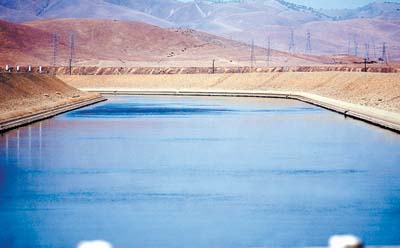
By SAMANTHA YOUNG
SACRAMENTO
A major earthquake along San Francisco Bay area faults could breach levees in the state’s delta region, wreaking havoc on California’s water supply and costing billions in levee repairs, according to a report released Friday.
The California Department of Water Resources says there is a 50 percent chance that 20 islands in the Sacramento-San Joaquin Delta would flood after a 6.7-magnitude earthquake. Repairs could cost up to $2.3 billion and take three years to complete.
In the meantime, water exports to 25 million residents in Southern California and the San Francisco Bay area would be disrupted, as would diversions to 3 million of acres of agricultural land.
The U.S. Geological Survey has estimated a 62 percent chance that a quake with a magnitude of 6.7 or greater will strike in the vicinity of the delta region by 2032. The San Andreas, Hayward or Calaveras faults pose the highest threat to the delta levees.
The delta stretches from the state capital to San Francisco Bay and is considered the heart of California’s water-delivery system, collecting water from Northern California’s major rivers before it is pumped south.
State water officials have known that earthquakes and flooding pose risks to the delta, but they said Friday’s report offers the most comprehensive look yet at the risks and costs associated with levee failures.
“The report is really focused on quantifying risks,” said Dave Marz, chief of the Delta-Suisun Marsh office in the Department of Water Resources. “It’s these faults that give us probably the greatest risk for delta assets and those assets that come through the delta.”
The delta’s 1,330 miles of levees are unstable for a variety of reasons. Most were built with peat soil and sand by landowners in the late 1800s and early 1900s.
Meanwhile, the islands that sit behind those levees have sunk as low as 25 feet below sea level, adding pressure to the already fragile barriers.
Experts say the energy of a major earthquake along any of the three faults threatens to liquefy the peat soils.
Deaths from earthquake-related flooding would likely occur because quakes come with no warning and flooding would be rapid. The report found a 40 percent probability of 90 or more deaths.
Flooding also poses risks to the delta, although not as severe as an earthquake. The report said flooding could cause an estimated 140 levee breaches over the next 100 years.
There is a 40 percent chance that 20 islands would flood at the same time, causing roughly $8 billion in economic costs, partly from lost farm production.
In 2006, California voters approved about $5 billion in bond funding for levee repairs. Marz said the water department intends to look at the risks identified in the report to determine how best to spend some of that money.
It also is completing a second phase of the report that is examining how the state could spend money to minimize the risks from earthquakes and flooding. That report is expected to be released later this year.
The Department of Water Resources has paid consulting firms URS Corp. and Jack R. Benjamin & Associates $13 million over the past three years to develop the report.









